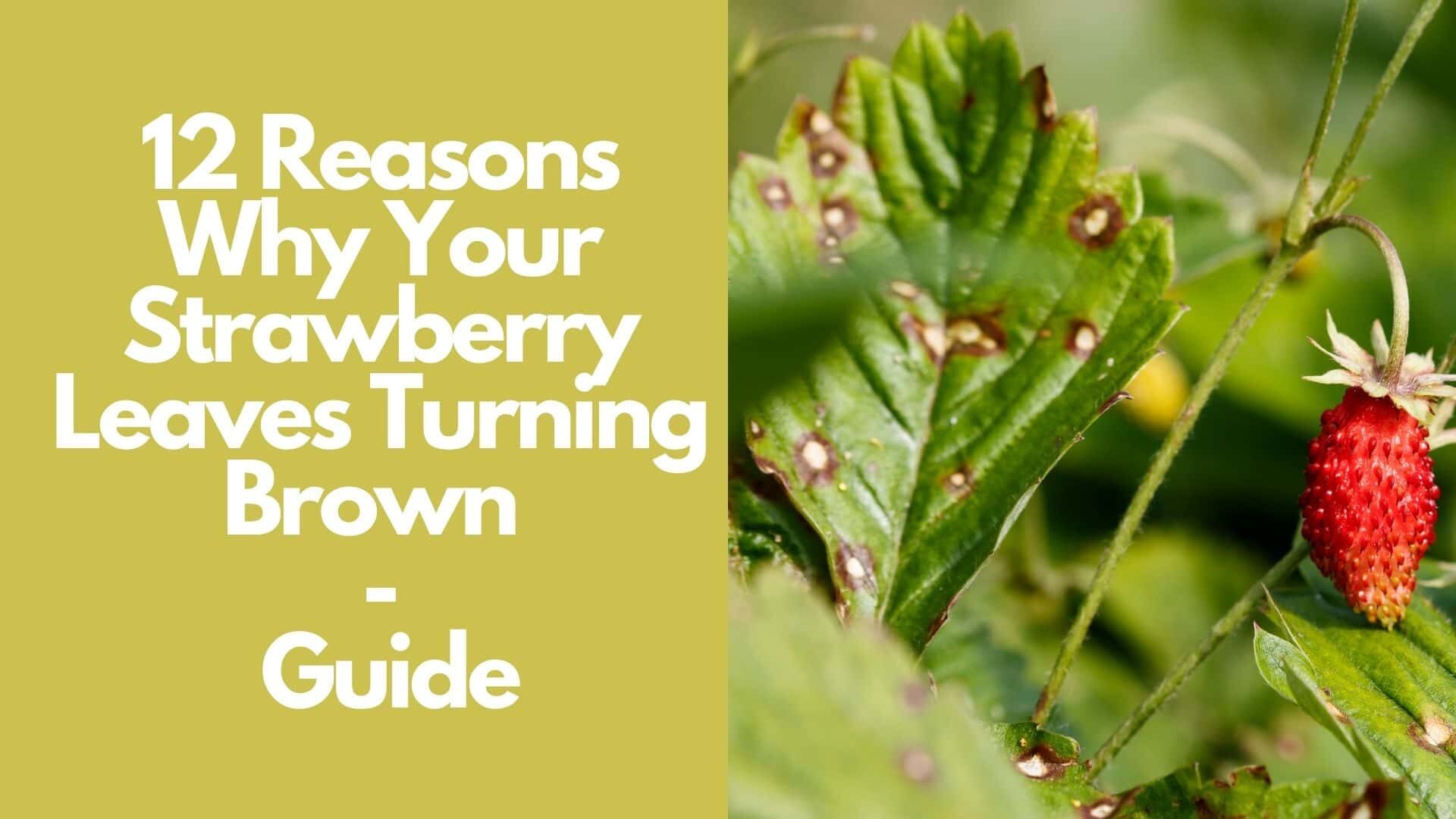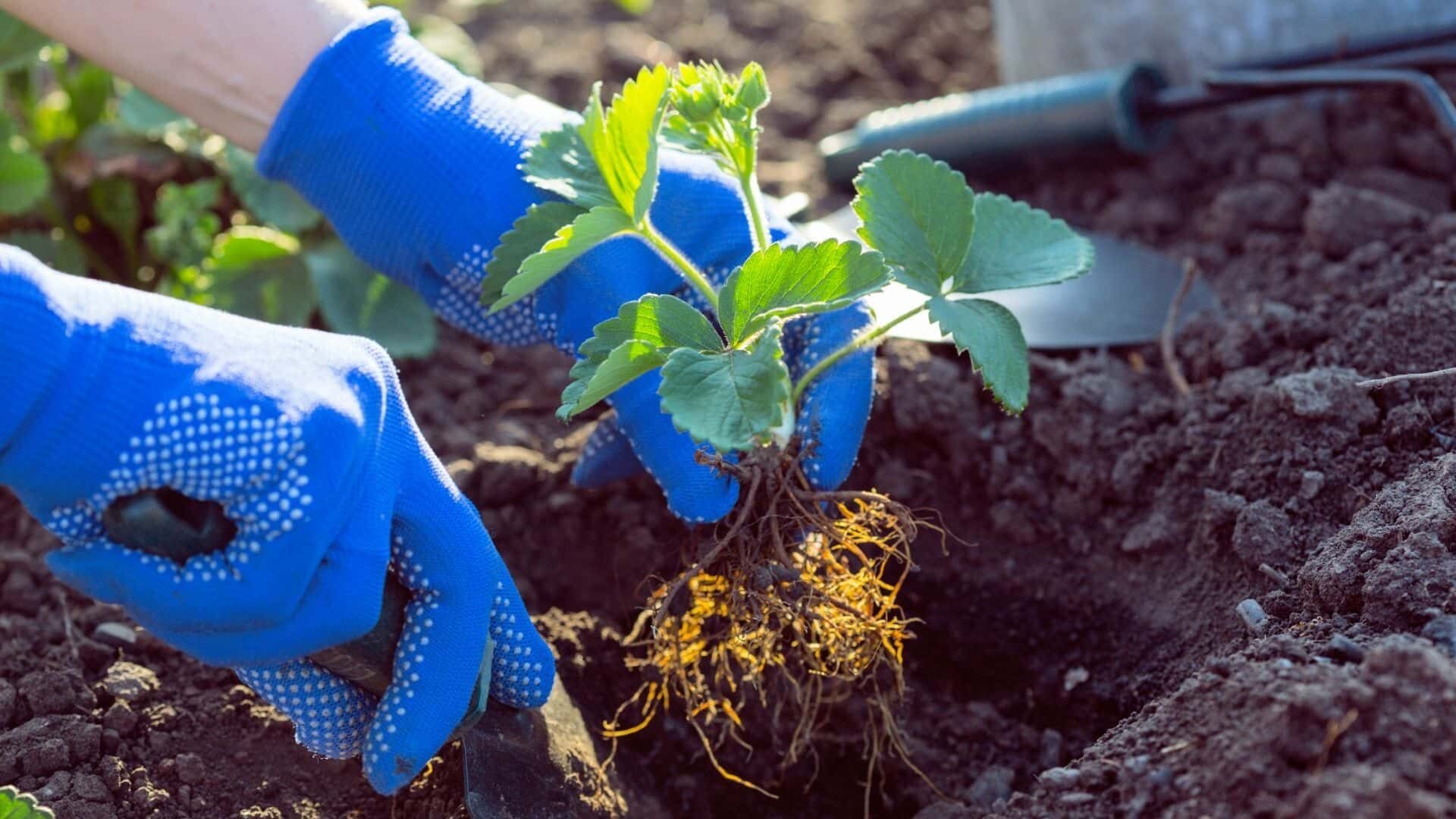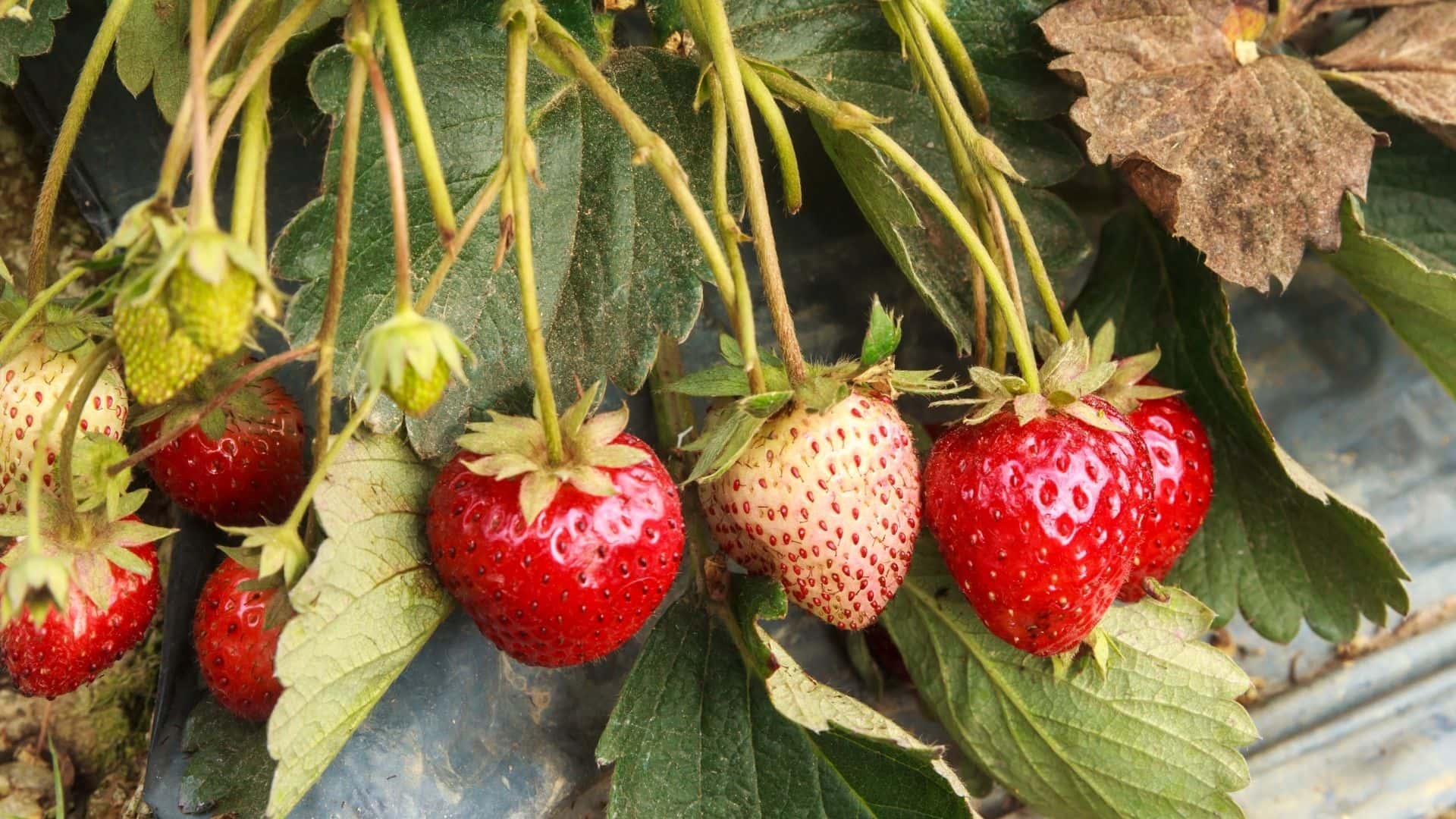Why are my strawberry leaves turning brown? Learn the 12 most risky causes and what to do to fix them before they harm your entire strawberry crop. Strawberry is one of the most widely consumed berries because of its high nutritional value and pleasant taste. It is grown all over the world for its sweet, fragrant, and juicy fruit.
It is widely accepted that strawberries have a calming effect on the senses and a stimulating effect on the stomach. These foods are easy to digest and have a strong laxative effect because of their fiber content, pigments, acids, and enzymes, which are all present. It has the ability to accelerate metabolism because of its high mineral content.
Strawberries are a lovely addition to your summertime home garden. Strawberry plants, on the other hand, aren’t easy to grow and care for. Browning of the leaves can be an indication that something is wrong with your plant for a variety of different causes. By reading this guide, you will be able to know, Why Are My Strawberry Leaves Turning Brown:12 Risky Reasons.

Let’s start,
If strawberry leaves turn brown, are they bad?
Different problems, diseases, and pests affect the strawberry plants, which can result in the browning of the leaves. Some of them aren’t damaging to the plant in the long run, but they can impair fruit output and development.
Some of the most common causes of brown leaves on strawberry plants can be deadly to a plant that is otherwise in good health and flourishing. So, browning strawberry leaves is not a good sign for your plant.
What are the reasons for turning strawberry leaves brown?
The brightly colored berries and leaves of strawberry plants set them out from other plants. As soon as your strawberry plants’ leaves begin to die and turn brown, it’s time to take action. There are several possible causes for this. So, let’s take a look at each of these factors and see if we can come up with a solution.
1. Root Damage
Root damage can occur if the soil around the plant is overly compacted or if the area around the plant has been flooded. When a plant’s roots are injured, it is unable to absorb enough water from the soil.
How to solve it?
To help the plant’s roots recover, fix the underlying issue that’s causing the harm and then prune it back to a smaller size.
2. Watering Issues
If the leaves on your strawberry plant are going brown, it’s most likely because you’re not watering it enough. Dehydration is most likely the reason for the browning of the strawberry plants, which ripen during the first few weeks of the summer.
Strawberries grown indoors require more frequent watering and should not be placed in an area of the house that is excessively hot or dry.
Strawberry plants do not like to be placed in wet soil, therefore if you have been overwatering your plant, it will show signs of stress, such as browning leaves.
How to solve it?
Your strawberry plant will thrive as long as you water it at the right time with the correct amount of water.
Water on the soil surface near the plant’s roots for the most effective method of watering. This will result in a significant amount of water being lost to evaporation when you apply water to plants or leaves. That could also lead to a fungal assault on the leaves of a plant.
Strawberry plants need to be watered early in the day or late at night, depending on the time of day you are gardening. Strawberry irrigation is most successful in the early morning hours. This gives the plants plenty of time to dry up before sunset. Strawberry pots need daily moisture checks if they are to thrive.
3. Over-fertilizing
You’ll notice browning on the sides and tips of your strawberry plants’ leaves if they receive too much fertilizer. Also, it may appear to be extremely dry. A plant’s roots are damaged if it receives too much fertilizer, making it impossible for it to take in water.
How to solve it?
Flushing your plants will remove any extra fertilizer, which is a simple fix.
4. Nematodes
A simple definition of nematodes is that they are small roundworms that wreak havoc on strawberry plants. Even if these worms aren’t a major threat to the plant at first, the situation can quickly change if they are allowed to multiply rapidly.
Strawberry nematodes are attracting brown leaves on your plants, which you can see. Plants can also be cultivated at a moderate pace.
How to solve it?
As a result, it’s best to conduct a soil nematode test before planting any crops. Nematodes are difficult to eradicate from diseased soil, however, chemical treatment of the soil can be useful in eliminating some varieties. Control and prevention can be achieved by using nematode-resistant crops while planting new crops.
5. Poor Soil Conditions
The water is unable to be retained by the soil. If you reside in a sandy environment, it’s possible that the water is just draining away too quickly, resulting in dark leaf margins.
How to solve it?
Improve the soil’s ability to retain water by adding organic material. Increase the frequency of watering in the meantime.
6. Lightning Issues
Too much direct sunlight on the leaves may be the source of brown stains in the centers of the leaves. In the summer, if you take your plants from the inside to the outside without acclimating them to direct sunshine, this is what will happen.
How to solve it?
If this is the case, you may want to consider shifting your plant to a position that is shielded from the sun’s rays.

7. Nutrient Deficiency
In the beginning, the lower leaves of the plant appear pale green to yellow (chlorosis). The beautiful yellow tint turns brown and covers most of the lower leaves as the disease progresses. Necrotic leaves and leaf drops are signs of severe deficiency.
How to solve it?
You may avoid nitrogen deficiency by having your soil tested on a regular basis. Repotting the strawberry plant in another nitrogen-rich soil or using a nitrogen source would be your only option.
8. Powdery Mildew
The first symptoms of powdery mildew are white, fuzzy patches on the leaves. The tips of newly emerging leaves will curl upwards. Mildew-infested leaves turn purple and then crimson on their undersides as they mature. The upper surface then develops a mosaic of purple, red, and brown patches. This disease rarely affects mature leaves because it prefers to infect newly developing tissue.
How to solve it?
Apply organically certified strawberries in mined sulfur or insecticide. Consider using varieties that are less sensitive to pests. Mildew growth is inhibited by direct sunshine.
9. Leaf Blight
Phomopsis obscurans, a fungus, is responsible for leaf blight. One to five-round reddish-purple dots appears on a leaflet as a first sign of leaf blight infection A light brown inner zone and a dark brown outside zone form when the spots expand to form V-shaped lesions.
Browning of the entire leaflet is possible. When leaf blight strikes in the late summer, it is particularly devastating to older leaves. Fruits that have ripened or are fully formed may also induce symptoms.
How to solve it?
In addition, fungicides can be used and strawberries watered at a time that they will dry out before night to slow its spread.
10. Leaf Spot
Lesions on older leaves turn from tan to white, with reddish-purple to rusty brown edges, while lesions on younger leaves retain light brown. These grow in diameter from 3 to 6 mm. A leaf can be killed by a cluster of spots. Strawberry stems, fruits, blossoms, and fruit caps can all be infected with the disease.
How to solve it?
By optimizing soil drainage and allowing enough circulation between your pots, you may help prevent leaf spots, which aren’t as destructive as other illnesses or plant problems.
A spraying combination of half a teaspoon of baking soda in one gallon of water can be used to treat leaf spots naturally. Fungicides, on the other hand, are an option. Leaf spot can be prevented by removing affected leaves from the plant.
11. Verticillium Wilt
Fungus called Verticillium albo-atrum and Verticilium dahliae produce Verticillium wilt in susceptible plants. As soon as your strawberry plant leaves begin to curl, turn brown, or wilt, it is more likely to be infected with verticillium. Over time, the soil becomes infected with verticillium wilt, a fungal disease. Unless it is spotted early, the disease enters weak plants through their stems and spreads throughout the plant’s vascular system.
How to solve it?
During this moment, the illness could be spreading into the soil around it. Get rid of any plants that have died from verticillium wilt right away. You should also get rid of the root system as well. Removing infected plant matter is necessary.
12. Leaf Scorch
Leaves that have been scorched appear to have reddish or brownish patches on them, which develop over time as a result of the scorching.
The leaf will turn brown quickly and perish as the disease spreads further. It’s common for leaves to appear scorched or burned before they die, which is why they’re called “charred.” Even the stems and fruit stalks are covered with these spore-bearing fungi.
How to solve it?
If a plant gets leaf scorching before it’s sold, it’s likely to have it. Before you buy a plant, inspect it to make sure you’re making a wise investment.
Lack of soil moisture in winter is the most common cause of winter-induced leaf scorch. Make sure the soil is free of any contaminated material and repot your plant into a new container to avoid the disease from spreading to healthy plants in the yard.
Using fungicide on sick plants may also help prevent the transmission of spores to new plants.
Should I cut off the brown strawberry leaves?
To encourage the growth of strawberry plants, you can remove the brown leaves. Infected leaves can be present in the plant. They should be pruned to prevent them from spreading throughout the entire plant. Prune is the term for this action. Eliminating non-recoverable dead leaves frees up soil nutrients for the remaining plants to use and consume.
Keep in mind to use sterilized scissors for pruning. When pruning, don’t chop the entire plant at once. Heavy trimming is bad for some plants, and strawberry plants are one of them. Additionally, you can remove dead stems and twisted roots. So, cutting the brown leaves is important to keep your plant healthy.
Can brown strawberry leaves turn green again?
After a strawberry plant’s leaves become brown, they will never return to their green color. It’s important to identify the root cause of your strawberry leaves’ browning in order to avoid it from happening again.
Proper care will result in new, healthy leaves on the plant. Make sure your plants are getting the nutrients they need by keeping an eye on them and providing them with what they need as needed.
Low-maintenance strawberry varieties to grow
Here are 5 low-maintenance strawberry varieties to grow in your garden. Grow them and harvest more.
1. Albion Strawberry
High in sugar and flavor, these day-neutral sweets won’t disappoint you. There are a number of varieties of this type that are resistant to verticillium wilting and other diseases.
They are also recognized for producing large amounts of fruit, ranging from one to three pints. Pollinators are drawn to white blossoms that are fragrant. With a moderate to fast growth rate, you can expect to harvest in around 90 days.
2. Charlotte Strawberry
Sweet berries will be available from June through the first frost of the fall thanks to this ever-bearing cultivar. The magenta-pink blossoms also attract pollinators, who find them irresistible.
This kind can withstand chilly temperatures and is also resistant to pests and powdery mildew. It grows to a height of 8-10 inches and a spread of 8-12 inches when it is fully grown.
3. Elan Strawberry
From July to October, this late-season everbearing variety’s beautiful biconical berries produce yields, and it’s noted for their ease of picking. Proximity to the ground and a spread of 14-18 inches are expected at maturity.
4. Eversweet Strawberry
This cultivar has cone-shaped berries that are extremely tasty, and it is noted for its ability to withstand extreme temperatures. It thrives in containers and compact places and is noted for producing high-quality fruit in its first year of growth.
When fully grown, the plants of this white-flowered everbearing variety stand 12-16 inches tall with an equivalent spread.
5. Grande Berries Treasure Red Strawberry
This is a fantastic choice for containers because of its lovely rose-colored semi-double flowers, trailing runners, and medium-sized red berries.
At maturity, you can expect a height of 12 to 16 inches and a spread of 18 to 24 inches. For this variety, you may expect to harvest in 28 days, with no chill-hour restrictions.
Watch How to rescue your strawberry plant after a triple digit heat wave | Video
Top 5 FAQs & answers related to 12 reasons why your strawberry leaves turning brown
Do strawberries grow best in pots or ground?
When it comes to long-term, perpetual growth, planting strawberries in the ground is the best option. While it is possible to grow in a container, the plant’s lifespan may be shortened as a result. Hanging baskets and flower pots are great for one growing season.
Which plants can grow near strawberries to prevent diseases?
All of the aforementioned vegetables, including rhubarb (which is really a vegetable) as well as asparagus, beans, peas, spinach, lettuce, garlic, and onion grow well alongside strawberries. Grown next to strawberries, legumes like beans and peas will enrich the soil and fix nitrogen, which will benefit the strawberry plants.
How often water to potted strawberries?
Potted strawberries need to be watered on a regular basis. Avoid both dryness and sogginess when growing strawberries in containers. By watering less frequently throughout the hottest months of the year, this can be achieved. The soil should never be allowed to dry out and should be kept moist at all times.
How long do strawberry plants last?
Strawberry plants can bear fruit for up to 5 or 6 years before they need to be replaced. Even though output can be drastically lowered after the first two years, a buildup of pests and diseases is possible. Prior to being cleaned and replanted, strawberry beds are typically held for a period of two to three years.
What should I do with my strawberry plants for the winter?
Plants that have finished producing should be cut back in order to encourage new growth for the following year’s supply of fruit. They’ll have time to establish some leaves for winter protection if they do it in the middle of summer. Strawberries that are harvested in June should be trimmed back in July.
Conclusion
By reading this guide, I hope you got the full idea of Why Are My Strawberry Leaves Turning Brown:12 Risky Reasons.
Please share this Why Are My Strawberry Leaves Turning Brown:12 Risky Reasons with your friends and do a comment below about your feedback.
We will meet you on next article.
Until you can read, Where to Position Your Greenhouse: Best Spots Guide
